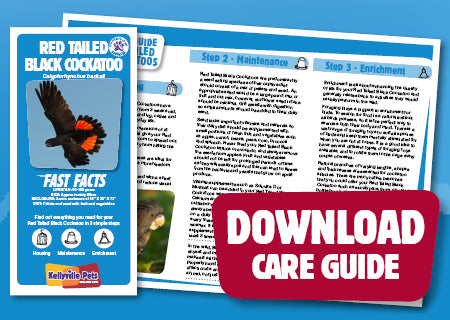This comprehensive care guide will show you how to look after a Red Tailed Black Cockatoo in 3 easy steps
Fast Facts:
How long will my Red Tailed Black Cockatoo live? 80-120 years
How big will it grow? Approximately 60cm
What size of enclosure is recommended for my Red Tailed Black Cockatoo? A wire enclosure of 65” X 30” X 75”
What does a Red Tailed Black Cockatoo eat? Pellets and seed with fruit and vegetables
Red Tailed Black Cockatoo Housing
Hand raised Red Tailed Black Cockatoos have been raised by humans usually from 3 weeks old, making them accustomed to handling, cages and many noises that occur in everyday life.
A thick gauge wire cage with dimensions of at least 65”(W) x 30”(D) x 75”(H) will give your Red Tailed Black Cockatoo enough room to spread out and exercise without risk of injury from hitting the wire sides. Open top cages with perching areas are ideal for hand raised birds as they provide more freedom and interaction with their family. At night the cage should be covered with a sheet or cage cover to prevent drafts and reduce visual stress.
Red Tailed Black Cockatoo Care
Red Tailed Black Cockatoos are predominantly a seed eating species so their captive diet should consist of a mix of pellets and seed. An appropriate seed would be a large parrot mix or fruit and nut mix, however, sunflower seed intake should be minimal. Grit assists with digestion so small amounts should be added to their daily seed.
Seed lacks important vitamins and minerals so their daily diet should be supplemented with small portions of fresh fruit and vegetables such as apple, carrot, beans, peas, corn, broccoli and spinach. Never feed your Red Tailed Black Cockatoo lettuce or avocado, and always remove the seeds from apples. Fruit and vegetables should not be left for prolonged periods of time as they will easily spoil and this can lead to illness from the bacteria and yeasts that grow on spoilt produce.
Vitamin supplements such as Soluvite D or Multivet can be added to your Red Tailed Black Cockatoos water two or three times a week.Calcium and Iodine can be provided through cuttlebone and iodine bells. Fresh water should always be available and should be changed on a daily basis. Worming should be repeated every three months with a broad-spectrum bird wormer. It is essential that a good quality calcium supplement such as Calcivet is given to the bird at least 3 times a week for the first year.
Red Tailed Black Cockatoo Feeding
Enrichment is all about enhancing the quality of life for your Red Tailed Black Cockatoo and generally relates back to activities they would usually perform in the wild. Foraging plays a big part in enrichment for birds. To search for food is a natural instinct all birds possess, so it is the perfect way to exercise both their body and mind.
There is a vast range of foraging toys to suit all species of birds and keep them mentally stimulated for when you are not at home. It is a good idea to have several different types of foraging toys available, and to rotate them in the cage every couple of weeks. Natural branches of varying lengths, shapes and thicknesses are essential for cockatoo species.
There are many native branches that you could offer your Red Tailed Black Cockatoo such as eucalyptus, gum, grevillea, bottle brush and lilly pilly, many of which have natural nuts and flowers that providing a foraging opportunity for your Red Tailed Black Cockatoo. This also allows Red Tailed Black Cockatoos to properly exercise their feet and beak as they can chew and strip the bark perches.

Licensing!
To own a Red Tailed Black Cockatoo you must hold a Class 1 Bird Keeper’s Licence.
This can be applied for online through the NSW Office of Environment & Heritage at http://www.environment.nsw.gov.au/wildlifelicences/applnformsandfees.html
We have created a Shopping list to show what you need to look after a Red Tailed Black Cockatoo:
- Cage; 65”x30”x75” thick gauge wire
- Water bowl
- Food bowl
- Perches
- Ozpet Litter
- Cage Tidy
- Cage cover
- Carry cage
- Pellets & Seed
- Vitamins
- Worming
- Avicare disinfectant
- Mixed treat nuts
- Lice & Mite spray
- Natural perches
- Cement perches
- Foraging toys
- Colourful toys
- Ladders
- Parrot Pad
- Play stand
Common health issues in Red Tailed Black Cockatoos
Psittacosis: A type of bacterial lung infection commonly carried by wild and domesticated birds, and able to be passed onto humans.
Respiratory Infections: Usually caused by bacteria infecting the respiratory system of birds due to vitamin A deficiency, however can be caused by many other factors such as fungi, parasites and environmental toxins.
Bacterial Infections: There are many common bacterial diseases birds are susceptible to and is usually caused by lack of hygiene or stress, especially when there is another factor compromising the birds immune system.
Red flags
Is your Red Tailed Black Cockatoo showing any of the signs of disease or illness? If yes, please contact your vet.
- Fluffed up feathers
- Nasal discharge
- Lethargy
- Out of character behaviour
- Discoloured poo or diarrhoea




At Kellyville Pets, we encourage responsible pet ownership.
CARE GUIDE © Copyright 2016 Kellyville Pets - All information found in this care guide is based upon our own experience. The information provided is not the only information available. In any medical situations, you should always consult your vet, including questions regarding your pet's diet.









